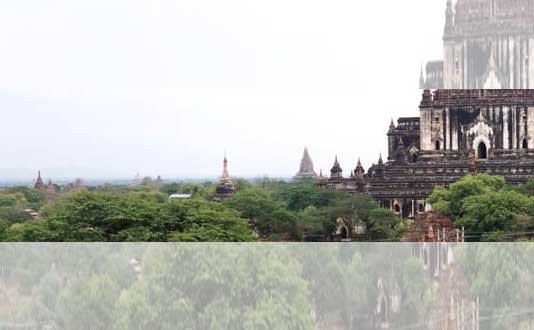
The beauty of Myanmar is in its Buddhist temples, pagodas, and different beliefs and rich traditions that locals cherish and visitors admire

Myanmar, one of the world’s most cloistered countries, has suffered five decades of military-backed rule. For a first-time visitor there, it’s a country with awe-inspiring pagodas in gold, monks in maroon robes, and their female counterparts, Bhikkhunis, in pink. Burmese people move around with Thanakha paste (made from Thanaka, or wood-apple tree) on their faces. It is a natural sun-block. Men and women both wear their traditional sarong, called longyi (same as our lungi). It is formal wear. Men can be seen wearing a shirt and tie with a longyi.
Curiously, traffic moves on the right side of the road in Burma. However, most of the cars being old models, have their steering wheels on the right side. The switch to the right side happened in 1962, presumably to break-away from the British colonial practice. Signage is mostly in Burmese and English or only in Burmese.
In 1989 the military junta changed the country’s name from Burma to Myanmar. Rangoon, which is the country’s largest city, became Yangon. It was also the capital city until 2006, but lost its position to a new, planned city (much like Islamabad) called Nay Pyi Taw. Yangon remains the spiritual and commercial centre and a melting pot, as several communities live here.
Some neighbourhoods remind me of Kharadar, or the Burns Road area of Karachi. Benches for customers are placed outside food stalls, and the cars are parked alongside. Jumbled-up cables, again much like Karachi, can be seen, and balconies have television dishes. Paan stalls, and shops selling ladoo, barfi, jalebi, etc make us feel totally at home. However, new office and residential buildings are coming up fast, as are stylish shopping malls. The Aung San Market in Yangon is a sprawling covered bazaar with more than a thousand shops and there’s a large selection of Myanmar fabrics, sarongs, jewellery, lacquerware, puppets, etc. There are, of course, food stalls, too. Peanuts are grown and consumed in abundance and are served in restaurants as appetisers, on the house.
There are countless old but decaying colonial buildings in Yangon that are an interesting sight, but the highlight of our stay here was the 2,500 years old exquisite Shwedagon Pagoda. The Pagoda is situated on a hill, and has four entrances. Right from the street level all the way up however, the steps are covered overhead and vendors sell flowers, statues, handicrafts and souvenirs.
This Buddhist temple complex comprises several small pagodas and hundreds of Buddha statues that surround a massive golden stupa. The hustle and bustle of the monks, nuns, and hundreds of other worshippers forms a dramatic scene in the setting sun which casts its magic on the shimmering gold of the Pagoda. I learnt that the domes are covered with hundreds of gold plates and the top of the stupa is encrusted with 4,531 diamonds, the largest of which is a 72-carat diamond. It is clearly one of the wonders of the religious world.
"No visit to Myanmar is complete without going to Bagan," I had been advised by a friend in Karachi whose roots are Burmese.
We therefore flew in an ATR plane from Yangon for 75 minutes and had a most memorable stay in this archaeological wonder located in the Mandalay region. Out of the tens of thousands of stupas, temples, pagodas and monasteries built here, over 2,000 have survived. Bagan (previously known as Pagan) was founded in the early second century. But it was in the reign of Bagan’s 42nd king Anawrahta (1044 - 1077) that provided a milestone in its development, and Theravada Buddhism flourished in Myanmar.
The archaeological area around Bagan is roughly 7 km x 7 km. The worst damage to the ancient buildings was done not so much in the past centuries as it was recently in August 2016, when an earthquake, measuring 6.8 on the Richter scale hit Bagan. Interestingly, it did little damage to the older parts of the buildings, built with stone or bricks. The new additions and restorative materials tumbled down though. We learn that the restoration and additional construction, with new materials such as concrete, was a misguided intervention by the former military rulers. Many of the damaged temples have been fixed, but there is still scaffolding on several other pagoda-tops that are under repair. Hotels and roads are being constructed to attract tourists. These developments, it is feared, will contribute towards damaging Bagan’s pristine beauty.
The most interesting thing about Bagan is that the historical monuments are not only visited as archaeological sites but are living buildings serving as present-day temples for worship. There are also hundreds of stupas, the dome-shaped Buddhist monuments that house relics of the Buddha. And there are the golden pagodas. The pagodas also contain relics, but they symbolise transcendence rather than Buddha’s earthly existence.
Our most ‘daring’ act was to climb a monastery atop Mount Popa, about 50 km from Bagan. As we moved closer to our destination, we saw the crop of mountain jutting out where the monastery is built on a volcanic block. You must go up 800 steps, and the climb is not easy, but we decided to take the plunge! There are monkeys inhabiting the staircase, ready to pounce on any food item. One has to be careful about food, as well as mobile phones and cameras. The view from the top of the mountain is indeed breathtaking.
Our trip to Myanmar was magical: visiting so many Buddhist temples and pagodas, and learning about the history, different beliefs and rich traditions that the people of that country cherish and we, as visitors, admire.